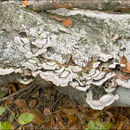en
names in breadcrumbs


Auricularia mesenterica, commonly known as the tripe fungus, is a species of fungus in the family Auriculariaceae. Basidiocarps (fruit bodies) grow in undulating densely-packed shelves that adopt a partially resupinate form.[1] A. mesenterica feeds saprotrophically on a number of woody substrates in deciduous forests.
Auricularia mesenterica was described by James Dickson as Helvella mesenterica in 1785,[2] and transferred to the genus Auricularia by Christiaan Hendrik Persoon in 1822.[3] Further genetic analysis has revealed an Auricularia mesenterica species complex, with A. mesenterica as the basal species.[4] The specific epithet is a Latin adjective formed from the Ancient Greek word μεσεντέριον (mesentérion), "middle intestine", from μεσο- (meso-, "middle, center") and ἔντερον (énteron, "intestine"), referring to its shape.[5]
This species forms bracket-like fruit bodies that first appear pale, rubbery, and button-like in shape, expanding to typically 3 to 7 cm (1.2 to 2.8 in) across and hardening with age. The fruit bodies often merge into compound structures sometimes running along fallen trunks and branches for more than a meter (3.3 ft). The upper surface is gray to brown, tomentose to hispid with concentric zones, while the underside is thickly gelatinous, irregularly folded radially, wavy and putty-like, and reddish-brown. The spore print is white.[6][7]
This species is considered a cosmopolitan species and grows on many different species of angiosperm wood, such as poplar, elm, and ash, typically in summer to fall.[8] It is a common species in Europe, but rare in the Americas and China.[9][4]
Before the fruit body fully matures and hardens, young specimens are edible, but in some local populations, these fungi tend to bioaccumulate high levels of heavy metals from their environment.[10] A. mesenterica has shown to have high levels of phenols, flavonoids, and antioxidant activity, having potential as antitumor agent.[11]
Auricularia mesenterica, commonly known as the tripe fungus, is a species of fungus in the family Auriculariaceae. Basidiocarps (fruit bodies) grow in undulating densely-packed shelves that adopt a partially resupinate form. A. mesenterica feeds saprotrophically on a number of woody substrates in deciduous forests.